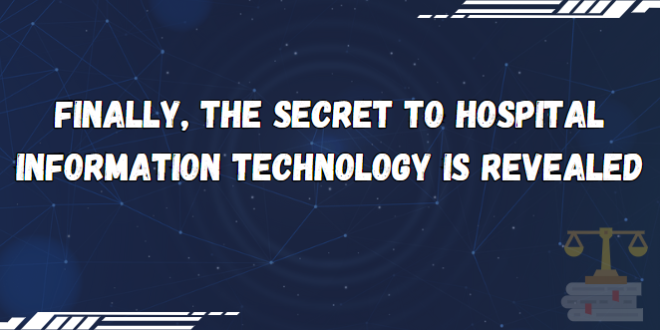
Hospital information technology (IT) plays a critical role in improving patient care, streamlining operations, and enhancing efficiency within healthcare facilities. However, the secret to successful hospital information technology implementation has remained elusive for many. In this article, we will reveal the key factors that contribute to the effective utilization of hospital IT systems.
1. Comprehensive System Integration
One of the secrets to successful hospital information technology is comprehensive system integration. Hospital IT systems should seamlessly integrate with various departments and functions, such as electronic health records (EHRs), laboratory systems, and radiology systems. This integration facilitates the flow of information and allows healthcare professionals to access and share critical data in real-time.
2. User-Centered Design
A user-centered design approach is crucial for hospital IT systems to be effective. User-friendly interfaces and intuitive workflows enable healthcare professionals to navigate the system easily and perform their tasks efficiently. By placing the user at the center of the design process, hospitals can optimize the usability and adoption of their IT systems.
3. Robust Data Security Measures
Data security is paramount in hospital information technology. Healthcare facilities handle sensitive patient information that must be protected from unauthorized access and breaches. Implementing robust security measures, including encryption, access controls, and regular system audits, ensures the confidentiality and integrity of patient data.
4. Scalability and Flexibility
Successful hospital information technology systems are scalable and flexible to accommodate the evolving needs of healthcare organizations. As hospitals grow, their IT infrastructure should be able to handle increased data volume and support additional functionalities. Flexibility allows for customization and adaptation to changes in workflows and regulations.
5. Training and Continuous Education
Proper training and continuous education are vital for effective utilization of hospital IT systems. Healthcare professionals need to be adequately trained on how to navigate the system, input and access patient data, and utilize its functionalities. Regular training updates and ongoing education programs ensure that users remain proficient and up-to-date with the latest system enhancements.
6. Collaboration and Communication
Hospital information technology systems work best when they facilitate collaboration and communication among healthcare teams. Integrated messaging platforms, shared calendars, and task management tools help improve coordination and streamline workflows. By fostering collaboration, hospital IT systems enhance overall patient care and promote efficient communication among healthcare professionals.
Conclusion
The secret to successful hospital information technology lies in comprehensive system integration, user-centered design, robust data security measures, scalability and flexibility, training and continuous education, and collaboration and communication. By implementing these key factors, healthcare facilities can unlock the full potential of their IT systems, leading to improved patient care, streamlined operations, and enhanced efficiency within the hospital setting.
 Spacetimes A collection of the latest news and information from various trusted sources
Spacetimes A collection of the latest news and information from various trusted sources
